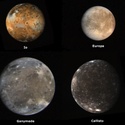An interactive on element formation and computer simulations of the night sky can be used to inform students about the location and life cycle of red giant and super red giant stars.
Instructions
-
View interactive: Universal element formation
Point out to the students that supernova explosions result in nucleogenesis – the formation of elements. The elements above lithium and below neptunium in the periodic table have all been made in supernova explosions. The elements that make up our world are indeed from the “ashes of long dead stars”.
-
Use Google Sky www.google.com/sky to locate the super red giants Betelgeuse and Antares, then locate the red giants Gamma Crucis and Aldebaran.
Point out to the students that, unlike most stars, which fuse hydrogen into helium, giants and super giants have exhausted their hydrogen supply and are starting to fuse heavier elements such as helium and carbon. Once these fuels are used up, the giants collapse into their core and trigger a massive explosion known as a supernova.
-
At a night-time viewing, students can easily locate these two super red giants and two red giants.
In summer, Orion becomes prominent in the north-western night sky. Along with the Southern Cross, it is one of the easiest constellations to recognise. New Zealanders see a saucepan or pot. Three bright stars form the base of the pot, and three faint stars its handle. The intense blue star on the handle side of the pot is Rigel. It is the brightest star in Orion, and the 7th brightest in the sky. Classed as a blue supergiant by astronomers, it shines with a light equivalent to 40,000 suns. Below the pot and diagonally opposite Rigel is Betelgeuse, a distinctive orange-red star. It is the second brightest in Orion and 10th brightest in the sky. A red supergiant, it has a diameter 500 times greater than the Sun’s.
Scorpius, a long S-shaped constellation, dominates winter skies. It lies overhead in late winter evenings. It needs little imagination to make out the shape of a scorpion. One of the largest stars in this constellation is Antares, which is a super red giant.
The Southern Cross is a prominent feature of the night sky. The star at the top of the cross is Gamma Crucis, which is a red giant.
Some students will have the star sign Taurus. The brightest star in Taurus is Aldebaran. It is the ‘eye’ of the ‘Bull’. The constellation Taurus lies adjacent to Orion.
These stars are ‘element’ factories, and when they supernova, there is a massive ejection of elements into the inter space medium.
-
Review interactive: Universal element formation
Point out that we are indeed made of the ashes of long dead stars.
Related content
Explore further in the article How elements are formed.
Planet Earth and Beyond – The night sky lists Science Learning Hub resources for teachers related to the rocky shore in the Planet Earth and Beyond strand of the New Zealand Curriculum.
Our astronomy topic covers a vast variety of articles, activities and media.
Useful link
For the first time, astronomers have witnessed the explosive death of a giant star in space, read about this event in this 2022 press release from Northwestern University, included is a video and link to the research paper. The discovery defies previous ideas of how red supergiant stars evolve right before exploding, demonstration how science is constantly changing as we learn more about the world around us.





